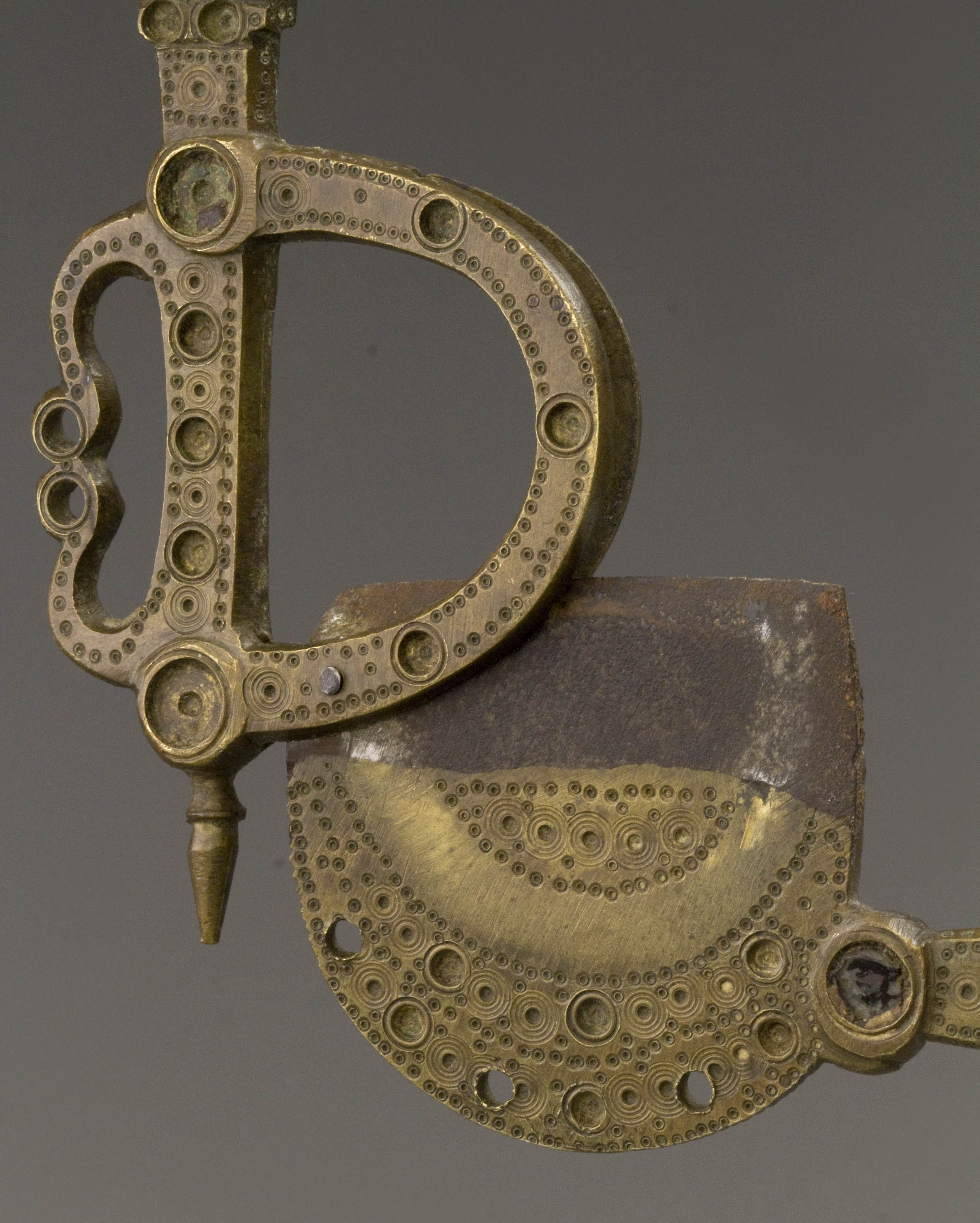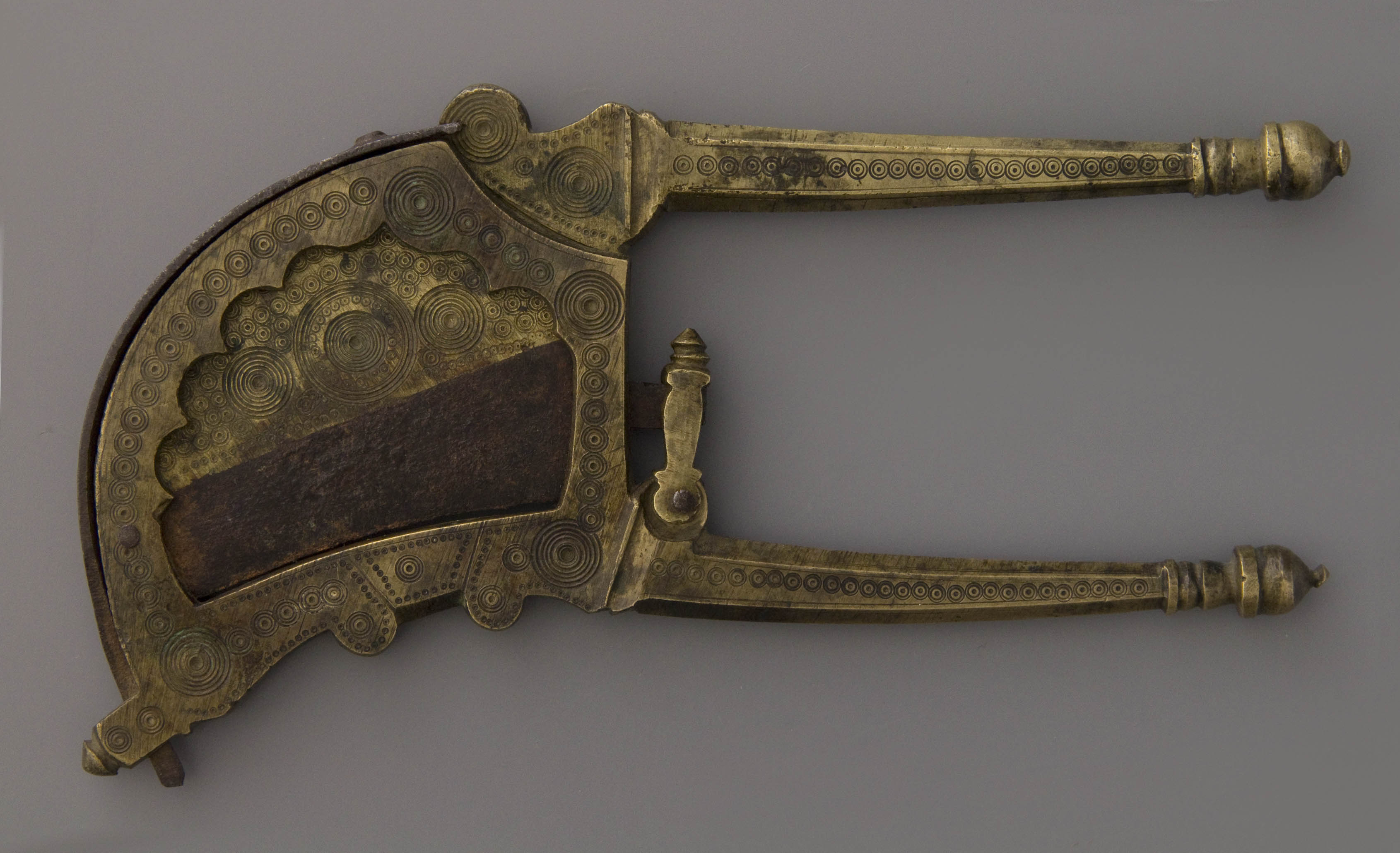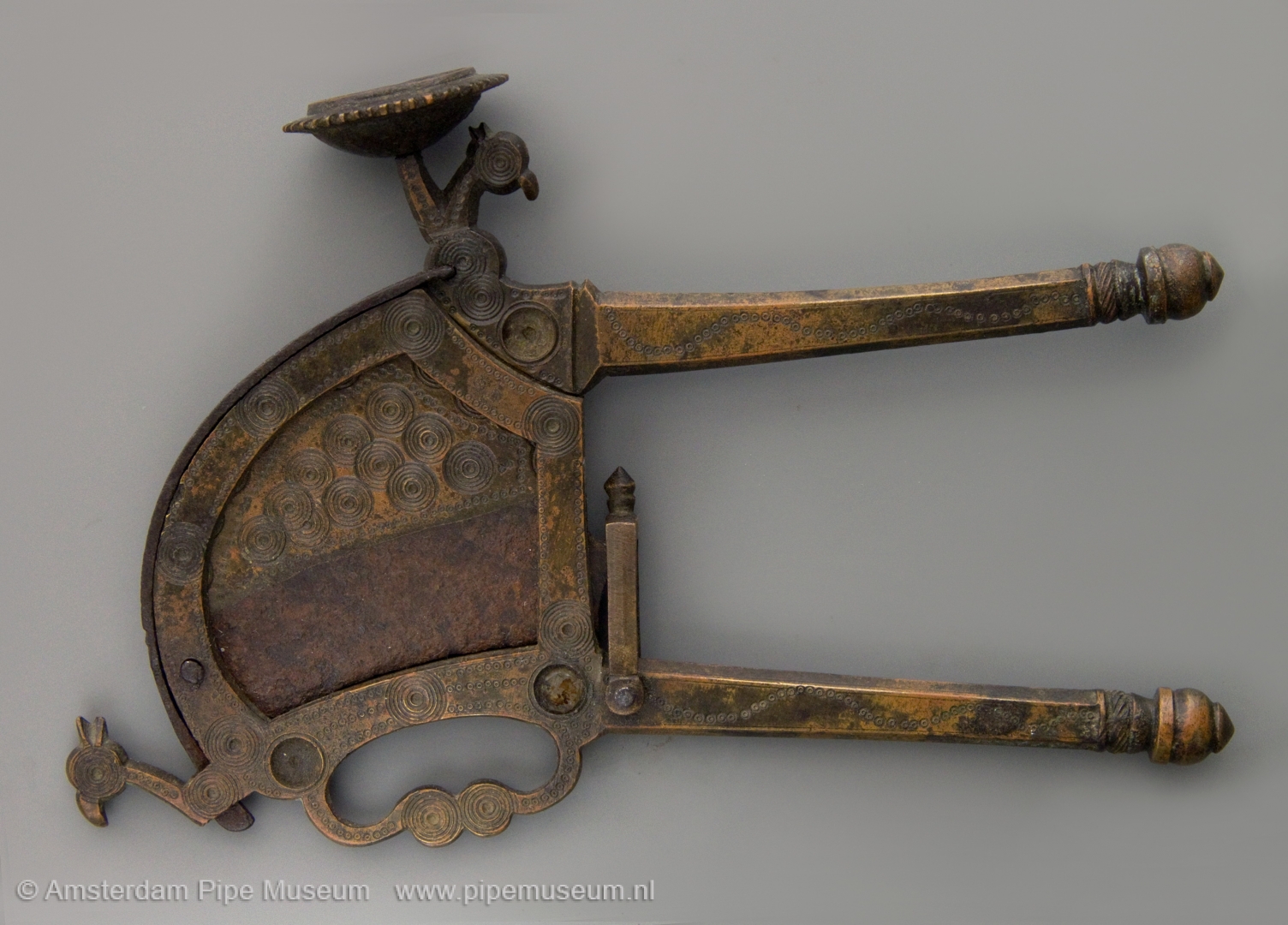Four remarkable areca nut cutters
Author:
Don Duco
Original Title:
Vier merkwaardige arecanootscharen
Publication Year:
2015
Publisher:
Amsterdam Pipe Museum (Stichting Pijpenkabinet)
Description:
Review of four richly ornamented and engraved areca nut or betel nut cutters from India.
Betel chewing or sirih taking are two names for a widespread stimulant in the east. From West India to beyond Indonesia, it has been popular for centuries for both men and women. The sirih or betel chewing package consists of a few pieces of the areca nut, commonly called betel nut, folded in a sirih leaf, mixed with some lime and, if desired, supplemented with tobacco or other ingredients. To crack the hard betel nut, a betel nut cutter is used, also referred to as betel nut scissors. It is a metal instrument between a pair of pliers, scissors and a nutcracker with which the hard nut is chopped into pieces. Incidentally, the formal name for these shears or clippers is the areca nut cutter to the eponymous note of the areca palm. Sometimes the name sirih sissors or sirih cutter is also used, although that is a rather unfortunate name because the sirih leave is not cut. In Indonesia one speaks of pinang schaar to the Malay word pinang for betel nut.
Such scissors occur in very similar form in many countries, always with their own local characteristics. They may have originated in Indonesia, but there is no proof for that. The general popularity of the betel nut and the practical use of these scissors or cutters made them spread throughout Southeast Asia for centuries. The scissors itself was indispensable because the dried betel nut is fairly hard and cannot be split in any other way. Only those scarce peoples who consumed the nut in fresh condition served a razor-sharp knife to cut the fresh nut into pieces.
This article is about four areca nut cutters from an Amsterdam collection. They were bought in the west of India in the 1980s. These are locally manufactured cutters that are a good example of the regional interpretation of the cutters. They differ by material use, design and decoration, while they are immediately recognizable as betel nut cutter. Also in terms of technical execution, these scissors are more striking than the usual examples from the Indian archipelago and the mainland of Southeast Asia.
A common feature of the Indian scissors is that brass prevails as material, while elsewhere in Asia wrought iron is customary. Of course, with the brass specimens the cutting part is always made of iron, otherwise it would become blunt too quickly. This cutting part usually consists of an elongated knife with a considerable height that falls into a cutting tray of the same length, the latter usually having a longitudinal groove. The edge of the cutter is sometimes roughened with hatching to better fix the nut. The knife rotates along a simple bolt hinge through which you could speak of a pair of pliers or scissors. The handles are straight as with pliers and without eyes like with scissors. In the examples discussed here, the knife is placed in a gate-shaped arch, so that the nuts remain better in position during cutting and cannot slide out of the scissors. The connoisseur speaks of the guillotine type against the usual betel scissors without guidance.



In addition to another material, the greater degree of luxury of betel scissors from India is particularly striking. In the four copies discussed here, an engraved decoration zooms the frame off the scissors, while in two cases the two handles are thickened with bone. The smallest pair of scissors (Fig. 1) is representative of the basic type. As said with an arch shape around the knife, covered handles with beautifully stylized horse heads at the ends. Finally, there is a curled ornament that runs under the scissors and has the shape of a fire striker. Whether that is purely coincidence or what is meant is an open question.
Charming as well is the engraved decoration consisting of so-called circle holes, one or more rings around a dot. They were applied with a special hardened drill. This decoration runs over the entire framework, including the handles. Some of the larger circle holes have been drilled to deepened dots. Sometimes they contain a stone, piece of glass or shiny mica. They break the rhythm of the engraved circle holes. Finally, there are three drilled holes along the top edge of these small scissors that served to hang loose ornaments. Whether that ever happened is unknown, the holes are in any case not worn out.
The decorated ends of the handles with the horse heads have already been mentioned and are not purely decorative. With their curved shape they give support in the palm and contribute to the grip during the cleaving of the nut. The hinge is very unobtrusively included in the arc-shaped blade strip and is marked with an extending pin. The lower edge of the scissors, together with this pin, offers the less muscular user the possibility to support the scissors by hand while keeping the nut between thumb and forefinger. The iron blade is fixed to the brass with a simple v-connection. All in all, an interestingly designed object has been created that, besides being functional, is especially attractive.



If we look at the second scissors (Fig. 2), we see very similar elements, but also considerable differences. Firstly, the specimen is almost twice as large and therefore a lot more impressive. Furthermore the design is more explicit with a heavier frame, while ornaments in the same style are even more striking. This is especially visible in and above the bow of the knife. Within the arch itself sawed-open fields are bordered with circle holes, above the arch you can see an openwork edge in which six balls have been cut which are drilled and contain pieces of transparent glass. On this bow we see three protruding animal heads, the outer peacocks and the inner a somewhat smaller horse head. Here too the eyes are filled with glass. The way in which the handles are thickened with bone corresponds to the first scissors. It is important that these handles show a slight curvature, resulting in a more playful silhouette for the entire object. Here too horses can be seen at the ends, albeit more stylized and with a curled mark referring to the waving mane of the animal. Because of that addition, the horse heads look more striking like everything else on these big scissors. In fact, the exaggerated decoration brings this blinker into imbalance, it has become a rather gaudy showpiece.
Despite their differences, the two scissors are very similar and that was why the collector kept them together. The first is modest and above all functional, the second clearly focused on impression and status. On the same base the maker obtained a totally different-looking result. Anyone who browses the publication of Henry Brownrigg - the only work on betel cutters - will discover that the large scissors can be executed even more exuberantly. He shows a copy with rosettes with mirrors along the top edge and also decorated with coloured beads. That scissors is really over the top.
Two other areca nut scissors (Figs. 3 and 4) also have the high arch shape as we saw with the two guillotine scissors in the previous, but their appearance is quite different. The flat handles with bone deco have now been replaced for hexagonal massive metal arms with multiple buttons at the ends. Very subtly the handles are rejuvenated in such a way that the scissor handles get a slight swing. The arch shape of the cutting section is rather quarter than semi-circle, but the underside of the scissor is always slightly curved. A technical invention is added to these scissors: a blade spring so that the scissors spring open again after cutting, ready for another cut. The iron leaf spring is a piece of wrought iron under tension, which is pushed into the scissors point and then fixed to the back of the scissors with a nail. The tension in the metal ensures eternal resilience. This leaf spring is a nice example of cooperation between the blacksmith who made the blade of the spring and the brass founder responsible for the scissors themselves. It is still unclear whether these two crafts were united in one person or whether they worked closely together, perhaps even in the same workshop. The leaf springs might even have been purchased in another region, although that does not seem likely.



Of this type with leaf spring, the largest one (Fig. 3) is the most weighted. There is no exaggeration here except for the decoration of the buttons on the handles and the continuous engraving with the circular holes already discussed, but now without the glass inlays. Even the spring catch on the inside of the scissors to keep them closed is simple but refined. This modest safety device protects the blade after use. However, the inside of the blade is toothed in a nice way that makes the design extra attractive but not exaggerated.
The second scissor with spring system (Fig. 4) has a somewhat more modest size but shows more explicit adornment. Under the scissor box, the fire striker shape has returned, which has already been discussed with the first two scissors. The marking of the hinge is indicated here with an protruding peacock head that is repeated at the top of the instrument. Above this top animal head we see a second addition, namely a mushroom-shaped brass dish. It gives the impression that the severed pieces of nut were served on this, but more likely it is pure ornamental. This dish could originally have been filled with a cabochon cut stone, a piece of glass or a mirror. So it only got a show function. Thanks to this transversely placed ornament, the scissors comes slightly upwards from the surface on which it lies so you can pick it up more easily. With the fourth scissors the inner bow of the guillotine is left very simple, not indented or arched at all.




Of the first two betel nut cutters, it is certain that they were made in Kutch, a region in the province of Gujarat, India. Local workshops for betel cutters that produced such remarkable gadgets, in line with the preference of the population for exuberant decoration. The two tools with leaf spring show just that difference that they can originate from the more northerly Rajastan. The addition of a leaf spring is a major technical change, but occurs from the north to the southernmost tip of India, while the decoration of circles is specifically related to the Kutch region. Therefore, the exact origin of these objects cannot be determined with certainty. This is surprising because this brass work has been produced in a large series, almost factory-made. Because sales were super-regional, traders brought the objects wherever they were in demand. This is precisely why the place of manufacture is now uncertain.
The dating of these areca nut cutters is another obscure matter. Betel nut cutters have been used for centuries and the primal form hardly changed. These are traditional objects with a very limited evolution. The four cutters discussed show a perfect user function combined with well-developed design and decoration. We consider these betel cutters examples from the final stage of development, there is nothing left to improve. That is why we date them as later examples in the first half of the twentieth century.
In India, betel belonged to one of the eight bhogas, pleasures in life. Betel chewing is both soothing to the body and stimulating to energy giving to the mind, it stops hunger and thirst. The areca or betel nut is the strongest flavour component of the chewing mixture. A strong user cut up to twelve nuts a day for his favourite habit. The taste can be enriched by added ingredients such as clove, cardamom or tobacco. That mixing was for some users a ceremony in itself for which special jars were used to store the ingredients.
With their attractive design and added decoration, the four presented betel cutters are not really everyday items. That is not necessary. The habit of areca nut chewing had a complex symbolic function. Offering the betel was highly regarded and often happened even before there was a conversation, it is seen as politeness and sign of welcome. In India the symbolic value went even further, betel was an entrance to higher spheres, even connected with the gods. In the courtship, at the wedding, also during the divorce it played an important role. Luxury scissors as discussed here remained stored during daily life to emerge as showpieces at high tide. This also explains the limited wear and tear of these objects. A precious betel nut scissors underlined the personal status of the owner, it was a conversation piece, a sign of good taste. In those situations they act as a prestige item, just as it applied to certain weapons and costume jewellery. When the status of the betel culture disappeared in the middle of the twentieth century, these four showpieces were sold for cash, eventually ending up with an Amsterdam collector's couple. They ensured that the once valued objects were given a place in our museum collection.
© Don Duco, Amsterdam Pipe Museum, Amsterdam – the Netherlands, 2015.
Illustrations
- Areca nut scissors with small size and bone handles. India, Kutch, 1900-1930.
Amsterdam Pipe Museum APM 1.357 - Areca nut scissors with large size and abundantly decorated. India, Kutch, 1900- 1930.
Amsterdam Pipe Museum APM 1.630 - Areca nut scissors with spring system. India, Gujarat, 1900-1930.
Amsterdam Pipe Museum APM 1.623 - Areca nut scissors with spring system and decorations. India, Gujarat, 1900-1930.
Amsterdam Pipe Museum APM 1.614
Litterature
Henry Brownrigg, Betel Cutters; from the Samuel Eilenberg Collection, Edition Hansjörg Mayer, Stuttgart, 1991.